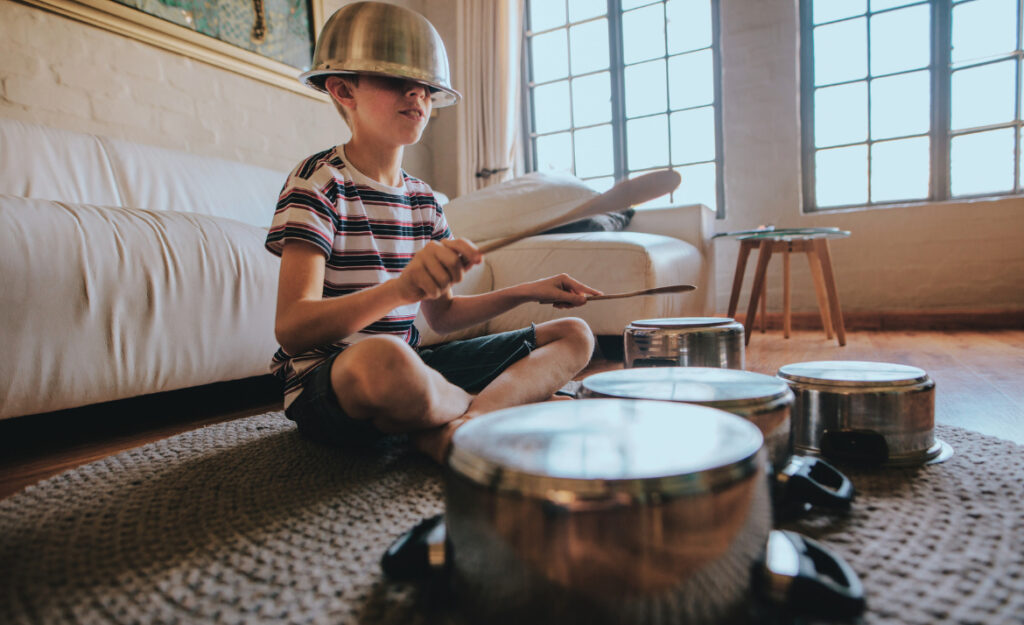Not everyone has access to a drum set at home, and practice without kit using everyday items can spark creative breakthroughs. This approach isn’t about restricting possibilities—if anything, it reveals new layers to your drumming.
Musicians learn resilience and versatility by adapting. Using objects like pillows, chairs, or old books hones accuracy and touch. These tools invite a fresh perspective into practice routines, adding challenge and fun.
Ready to rethink how you use your space? This guide explores real, hands-on techniques to reinforce your skills and creativity—no kit required. Let’s get started!

Repurposing Household Items for Drum Practice Delivers Surprising Results
Turning household items into practice tools develops hand technique, coordination, and dynamics. Start by collecting items with varying surfaces like cushions, plastic containers, or rubber mats for diverse practice sessions.
Approaching each object as a fresh drum pad naturally changes your touch, making you pay closer attention to bounce, rebound, and control on any surface.
Pillows for Developing Stick Control
Pillows absorb almost all rebound, forcing you to lift and control sticks consciously. Practicing doubles or singles here strengthens wrists, so when you return to drums, your endurance and control noticeably improve.
Try practicing basic paradiddles on a firm pillow, counting aloud, and watching wrist height in a mirror. If it feels awkward at first, you’re engaging new muscle memory.
Counting “one, two, three, four” out loud adds accountability and ensures proper hand movement, crucial for students struggling with ghost-notes or subtle accents in practice without kit drills.
Boxes and Buckets for Dynamic Workouts
Using cardboard boxes or upturned buckets mimics floor toms with unique tones. They’re especially useful for rudiment workouts that require accent and tap contrast.
Using two buckets or a bucket and box lets you alternate right and left hands, like snare and tom. This method helps with transitioning across the kit in imagined set-ups.
Start slow, increasing speed as coordination improves. This scenario mirrors how drummers would warm up before gigs backstage without access to their drums.
| Object | Surface Type | Best Skill to Practice | Takeaway |
|---|---|---|---|
| Cushion/Pillow | Soft, No Rebound | Stick Control | Builds strength and wrist development |
| Plastic Bin | Firm, Loud | Accents, Dynamics | Focus on volume control |
| Books | Hard, Low Bounce | Speed, Repetition | Helps maintain stick angle |
| Rubber Mat | Bouncy | Rebound Practice | Simulates practice pad feel |
| Pots/Pans | Metallic | Movement, Quick Attacks | Great for fills and improvisation |
Transform Your Couch and Floor into Interactive Practice Zones
Assigning different parts of your living room or workspace to ‘imagine’ drum shapes trains your mind and limbs. Let the couch serve as a snare and the rug as a hi-hat.
Label each spot mentally and practice moving through patterns, using words like “snare, hi-hat, floor tom” as you play for added precision.
Mapping an Imaginary Drum Set
Designate pillows, furniture edges, and carpet squares as drums and cymbals. Name each object aloud, then run through basic grooves to establish spatial memory before experimenting with more complex beats.
- Mark your snare zone on the couch: Focus on right-hand consistency, as you would on a real snare. This develops muscle memory for your strongest hand.
- Define a “hi-hat” space using a rug: Concentrate on rhythm with your leading hand. This makes transitions easier in practice without kit attempts.
- Choose a chair armrest as a tom: Practice rolls between snare and tom. Accurate placement means better crossover in live playing.
- Establish a “kick drum” area with your foot on the ground: Always keep your heel planted for control, replicating energy used on a real pedal.
- Use a stack of magazines for a crash cymbal: Strike with a flick of the wrist, capturing the quick attack moment for accent work.
Running patterns with these cues locks in your muscle memory, so when you return to your kit, you’ll navigate each piece with ease.
Incorporating Foot Pedal Drills
Air-drumming your kick by tapping your foot on hard floors strengthens your ankle motion. Make each hit deliberate rather than loose, focusing attention on timing more than force for real-world accuracy.
- Place your heel directly under your knee: Brings balance and prevents foot strain.
- Tap in sync with stick patterns: For full-groove coordination, count out loud as you play.
- Try double-strokes with your foot: Builds stamina for faster bass drum parts.
- Alternate sides if possible: Prevents fatigue and cultivates bilateral movement.
- Stand and mimic full drum set posture: Reinforces authentic performance form, even without a drum pedal.
Commit to daily five-minute foot drills and you’ll see smoother transitions when you’re back on your real kit.
Reimagining Groove Practice with Basic Objects
Groove is about flow and consistency, not fancy gear. For practice without kit, ordinary tools like pots or desktop edges provide distinct sounds mimicking snare, hi-hat, or ride.
Choosing three surfaces, tap out typical drum set rhythms—slow at first, then quicker—to stabilize tempo awareness and control. Visualize the set, mentally assigning each sound a kit part.

Drumming Fundamentals to Make You Sound Better Fast
Get hands-on advice and proven routines for drumming fundamentals that will boost your timing and groove.Using Pots and Pans to Mirror Real Drumming
Imagine a pot as your snare and a pan as your cymbal—then loop eight-bar patterns, counting at each strike. The weight and feedback from these objects will refine stick height and attack precision.
Alternate strong and weak hand leads, as you would switching between eighth and sixteenth notes. This multi-surface approach sharpens your listening, a crucial step in realistic drumming situations.
If you stick to the pattern for a full three minutes without slipping, you’ll notice steadier tempo in future sessions—even before returning to your kit.
Improving Dynamics with Magazines and Books
A heavy book as your ‘marching snare’ trains hand strength, since the rigid surface requires more control to avoid bounce. Practice soft taps and loud slaps for sensitivity.
Slide magazines on a surface for brush emulation, developing nuanced touch ideal for jazz, Latin, or subtle pop songs. Alternate quick and slow sweeps, listening for changes in timbre.
Integrating these objects gets you comfortable controlling volume, which directly translates to controlled live playing. Consistency is your goal with every hit.
Training Precision with Non-drum Tools Encourages Focus
When you strip away the visual reminders of a drum set, you’re compelled to focus on motion and accuracy. Using utensils or pens as sticks hones grip and supination control.
Your hands memorize micro-movements required for clean doubles, tight rolls, and sharp ghost-notes. The lack of rebound from these objects forces concentrated effort—translating to cleaner technique at the kit.
Replacing Sticks with Chopsticks for Finger Dexterity
Chopsticks are lighter and narrower than drumsticks. Practicing control exercises on harder surfaces strengthens your fingers, perfect for rudiment training away from the drum pad.
Run single-stroke rolls, emphasizing quiet rebounds by using your fingers instead of your wrists. This exercise trains subtle grip adjustments that make advanced patterns cleaner and more relaxed.
Practice accent patterns using the phrase, “tap, tap, SNAP,” to internalize dynamic contrasts, which is essential for musical expressiveness.
Using Spoons and Whisks for Unique Accents
Spoons and whisks create metallic, varied timbres on pots and pans. Explore new grip angles, alternating between power and finesse to produce clear, even sounds.
Experiment by dragging a whisk across ridged lids—this emulates wire brushes on a snare, ideal for jazz practice without kit and cultivates flexible technique.
Refining your approach with these objects prompts you to seek fresh textures and interpretations, crucial for creative live playing.
Building Independence and Limb Control through Object-Driven Routines
Practicing four-way independence with household objects deepens coordination between hands and feet. Each limb can strike a different object—box, pillow, book, and floor—at once, reinforcing the independence required for complex beats.
Assigning unique sound sources to each limb builds the listening and reaction skills necessary for varied grooves, letting you experiment with polyrhythms and syncopation without leaving your living room.
Performing Limb-Specific Challenges
Play single strokes with sticks on a cushion, sync your foot taps to an even quarter-note count, then add a simple hi-hat rhythm using a desk’s edge.
Challenge yourself to add one limb at a time. Repeat each step until it feels automatic before progressing to the next. This approach ensures a solid foundation for more complex patterns.
If the rhythm falters, pause and isolate the weakest limb. Work on it separately, then blend all movements once more for a seamless groove.
Developing Faster Fills with Object Rotation
Rotate hands between different hard surfaces—table corners, stacked books, or kitchen counters. Start by alternating right and left hands every four beats and gradually shorten the interval.
Introduce triplets, moving as quickly and cleanly as possible between each surface. Focus on even stick height and wrist angles, aiming for consistency in every fill.
Establish a metronome on your phone to track progress, rewarding yourself after each successful tempo increase for positive reinforcement.
Avoiding Common Pitfalls in Non-kit Practice
Enthusiasm for practice without kit sometimes leads to technique slippage if you’re not attentive. Always maintain proper posture—feet flat, shoulders relaxed, back upright—even without a chair or drum throne.
Monitor your sticks or household stand-ins: keep grip loose, movement wrist-driven, and rebound controlled. This prevents bad habits that might slow progress when returning to the physical kit.

Checklist for Object Practice Efficiency
Stay aware of these basics to maximize growth and avoid injury. Save this checklist for every session:
- Warm up hands and wrists for five minutes: Reduces strain and prevents long-term injuries from repetitive motion.
- Start at a slow tempo and build speed: Ensures clean technique translates from objects to the real kit.
- Practice regularly, ideally daily: Repetition cements patterns in muscle memory, building confidence and fluency.
- Switch objects after ten minutes: Keeps focus sharp and prevents boredom, pushing creative boundaries.
- Evaluate comfort and hand fatigue: Stop if pain develops and rest before the next session to ensure longevity as a drummer.
Maintaining these steps means better results and smoother transitions back to your drum set, regardless of your current resources.
Carrying Benefits from Creative Home Practice Back to the Drum Kit
Every technique you strengthen during practice without kit transfers immediately to your drum set. Improved finger dexterity, consistent tempo, and dynamic sensitivity appear the moment you strike real drums again.
Your imagination expands—each diverse household object pushes you to rethink groove, accent placement, and hand coordination, making actual drum set routines feel fresher and less intimidating.
Reintegrating Newfound Skills into Kit Routines
After several weeks of home sessions, start with basic grooves on your real kit. Notice improved stamina and faster transitions between drum parts—the result of adapting to varied practice surfaces.
Incorporate warm-up stretches learned at home to prevent injury, and don’t abandon everyday object drills. They complement kit practice, especially when time is short or gear isn’t accessible.
This fusion of skills elevates your overall musicianship, strengthening both technical prowess and adaptability in rehearsals or performances.



